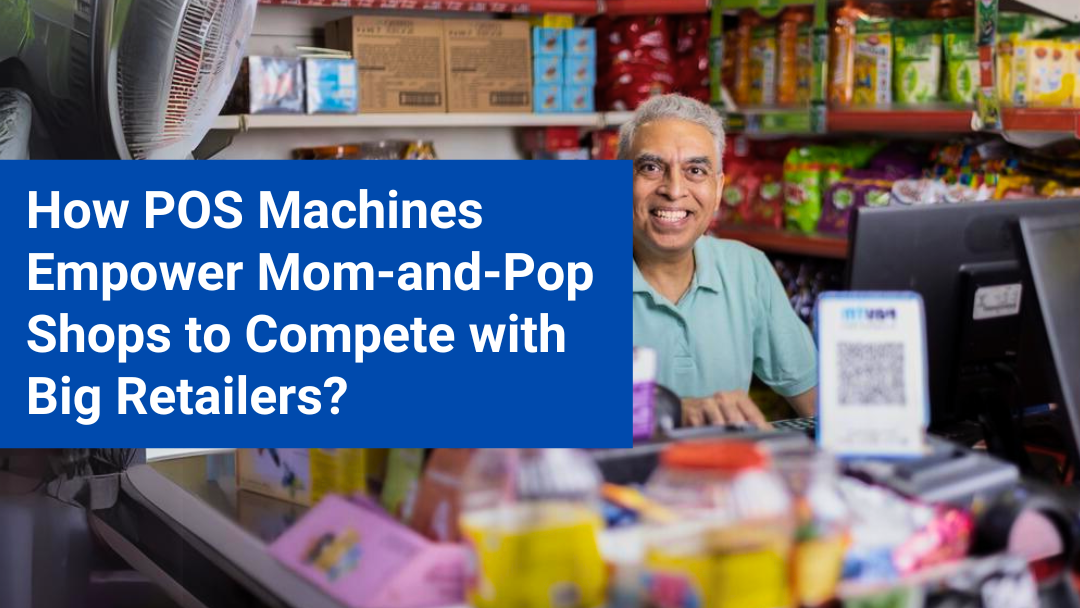How POS Machines Empower MOM-and-POP Shops to Compete with Big Retailers?
Do you run a mom-and-pop shop but are confused if you should invest in a POS machine? If yes, this article will clear all your doubts and help you make an informed choice. To explore, read till the last.
What are the challenges faced by mom-and-pop shops?
Without point-of-sale (POS) machines, mom-and-pop shops face several operational and competitive challenges, especially compared to larger retailers who benefit from advanced technology. These challenges include:
1) Manual Transaction Processing: In the absence of POS systems, mom-and-pop shops often rely on manual cash registers or handwritten receipts, which are time-consuming and prone to errors. Calculating totals, taxes, and changes manually increases the risk of mistakes, leading to discrepancies in financial records and possible customer dissatisfaction.
2) Limited Payment Options: Shops without POS machines are often limited to cash transactions, which can deter customers who prefer using credit/debit cards, mobile payments, or digital wallets. In today’s cashless society, this limitation reduces potential sales and puts the business at a competitive disadvantage.
3) Inventory Mismanagement: Without a POS system, managing inventory often becomes a manual and inefficient process. Shop owners might not have real-time data on stock levels, leading to overstocking or stockouts. This lack of control can result in lost sales opportunities, unhappy customers, and increased costs due to poor inventory planning.
4) Lack of Sales Data & Insights: POS systems provide valuable insights into sales trends, popular products, and customer behaviours. Without such systems, mom-and-pop shops are left without actionable data, making it difficult to analyze which products are selling well, what times are busiest, or how to optimize pricing and inventory.
5) Difficulty Implementing Loyalty Programs: Loyalty programs can help small shops retain customers, but managing them without a POS system can be difficult. Tracking purchases and rewards manually is inefficient and often prone to errors, leading to customer dissatisfaction and lost opportunities to encourage repeat business.
6) Slow Checkout Process: Manual processes slow down the checkout experience, especially during peak hours. In contrast, larger retailers with POS systems can handle transactions faster, resulting in less customer frustration and shorter wait times. Long lines and slow service may lead to customer attrition, especially in today’s fast-paced retail environment.
7) Limited Ability to Track Financial Performance: Small shops without a POS system may struggle with tracking and reconciling financial transactions. It becomes challenging to maintain accurate records of daily sales, taxes, discounts, and returns. This can lead to cash flow issues, accounting errors, and problems with tax reporting.
8) Challenges in Expanding Sales Channels: Without a POS system, it’s harder for mom-and-pop shops to sell through multiple channels, such as online stores or marketplaces. The ability to integrate e-commerce with in-store sales is critical in today’s retail environment, and without POS systems, small shops miss out on opportunities to expand their reach beyond their physical location.
9) Increased Risk of Fraud and Theft: Manual transaction handling makes it easier for errors, fraud, or theft to go unnoticed. Without proper tracking and real-time reporting, it becomes difficult to identify discrepancies in sales or inventory, which can result in financial losses.
10) No Centralized Record Keeping: A POS system provides centralized data storage, making it easy to manage and access transaction histories, customer data, and inventory records. Without one, mom-and-pop shops may have to keep separate records for each aspect of their business, increasing the complexity of managing operations and reducing efficiency.
In short, the absence of POS machines results in inefficiencies, errors, missed sales opportunities, and an inability to compete with larger retailers who leverage technology to streamline their operations and improve customer experience.
How do POS machines empower mom-and-pop shops?
Point of Sale (POS) machines are significantly empowering mom-and-pop shops to compete with big retailers in several key ways:
1) Streamlines Transactions: POS machines enable small businesses to accept various forms of payment, including credit cards, debit cards, and mobile payments like Apple Pay or Google Pay. This flexibility allows these shops to cater to more customers, whereas big retailers have long offered such convenience. Faster and more secure transactions also reduce waiting times, enhancing customer experience.
2) Manages Inventory: Modern POS systems often come with inventory management features that allow small shop owners to track stock levels in real-time. This helps prevent overstocking or stockouts and ensures they always have the right products available, which improves competitiveness.
3) Provides Customer Insights: POS systems collect valuable data about customer purchasing habits, which can be used for personalized marketing and promotions. Big retailers rely on similar insights for targeting customers with offers, and now smaller shops can do the same, giving them the power to build customer loyalty through tailored promotions.
4) Improves Efficiency and Accuracy: Automating calculations, tracking sales, and managing orders minimizes human error in transactions, reduces fraud, and ensures smooth operations. This efficiency allows mom-and-pop stores to run with fewer staff while maintaining accuracy, something big retailers often achieve through more advanced systems.
5) Provides Data Analytics: Many POS systems offer sales reports and analytics, helping small shops make informed decisions about products, pricing, and peak business hours. By identifying trends, small retailers can adjust their business strategies to stay competitive with larger stores that benefit from big data analysis.
6) Caters Omnichannel Capabilities: Some POS systems integrate with e-commerce platforms, allowing small shops to sell online as well. This omnichannel approach lets mom-and-pop stores compete in the growing online retail space, where larger retailers often dominate, without needing to invest in expensive IT infrastructure.
7) Encourages Loyalty Programs: Many POS systems come with built-in loyalty program options, allowing small businesses to reward repeat customers with discounts or special offers. This strategy helps to build a loyal customer base, just like the rewards programs offered by big retailers.
8) Supports Cost Savings: While large retailers can afford complex systems, modern cloud-based POS solutions are affordable for small shops. They provide similar capabilities at a fraction of the cost, leveling the playing field when it comes to technology.
By offering these functionalities, POS systems give mom-and-pop shops the tools they need to provide a high level of service, improve operational efficiency, and make data-driven decisions, allowing them to better compete with large retailers.
SUMMING UP
POS machines are crucial for empowering mom-and-pop shops by improving efficiency and competitiveness. They allow small businesses to accept diverse payment methods, streamline transactions, and reduce errors, offering a more professional shopping experience.
POS systems also help manage inventory in real time, track sales data, and provide customer insights for personalized marketing and loyalty programs. Additionally, they enable integration with e-commerce, expanding sales channels beyond the physical store. By enhancing accuracy, reducing fraud, and providing essential business analytics, POS systems give small shops the tools they need to compete with larger retailers more effectively.

